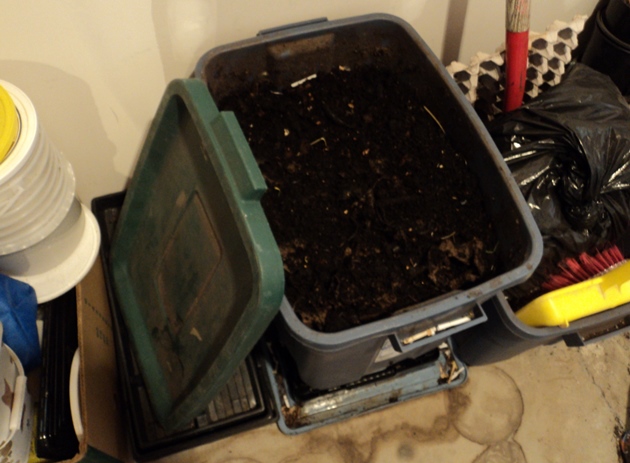
Compost tubs (indoor method)
courtesy of the Saskatchewan Waste Reduction Council
Compost tubs are a way of making compost indoors using a large tub on a drip tray. Moderate amounts of food waste are layered with shredded paper and dry soil. This method is effective but requires close monitoring.
- Drill holes in the sides and bottom of a large tub, and set it on top of a drip tray. Put some egg cartons or other spacers beneath the tub so air can circulate between it and the drip tray.
- Add a 1-2" layer of dry soil or finished compost to the bottom of the tub.
- Add a 1-2" layer of dry shredded paper or sawdust to the tub.
- Begin adding food waste (vegetable or fruit scraps, tea and coffee waste, grain-based products, and egg shells) to the tub. Balance each addition of food waste with an equal amount of dry soil and shredded paper or sawdust.
- Place the lid loosely on top of the tub.
- Carefully fluff or stir the contents of the tub every week or so. Try not to overfill the tub.
What composting style do they fit?
Compost tubs require a solid understanding of how to balance compost ingredients and close management, so they work best for hands-on composters. Hands-off composters should try a simpler indoor method like bokashi buckets or vermicompost.
What space does it need?
Compost tubs need an indoor space, and work best in a garage or basement.
How do they work?
Compost tubs are a form of aerated composting which relies on naturally-present decomposition microbes to digest organic waste and turn it into finished compost. These microbes require 5 things to function properly:
- Green material* (this should be about 40% of the mix)
- Brown material** (this should be about 60% of the mix)
- Moisture
- Oxygen (air)
- A small amount of soil or finished compost
*Green materials are nitrogen-rich, fresh stuff such as green plants, grass clippings, and kitchen waste. Kitchen waste here includes vegetables and fruits, tea bags, coffee grounds and filters, egg shells, and grain-based products but excludes meat, bones, dairy, and grease.
**Brown materials are carbon-rich, weathered stuff such as dead leaves, dead plants, sticks, woodchips, and shredded paper products.
If the compost doesn't seem to be breaking down, check that it is still damp all the way through. Add water if necessary. If it is damp and still not breaking down, consider adding additional green materials* to the mix.
If the compost has a putrid smell, fluff it to add air and stir in additional brown materials** or dry soil.
Can you use it all year?
Compost Tubs are an indoor system and can be used all year.

